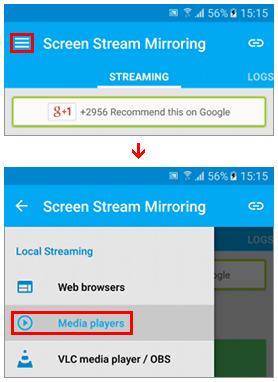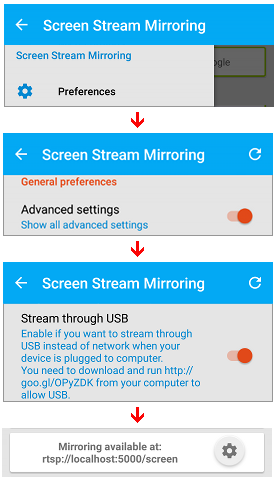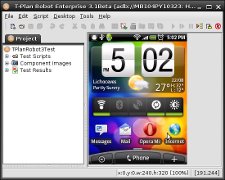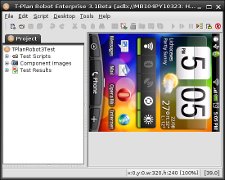Last update: 5 January 2018
Contents:
1. Introduction
2. Setting Up
2.1 PC Set Up
2.2 Android Device Set Up
2.3 Connecting To Robot
2.4 Screen Stream Mirror
2.5 Performance Considerations
3. Troubleshooting
4. Automation
4.1 Connecting To The Device
4.2 Dealing With Screen Rotation
4.3 Touch Screen Automation
4.4 Keyboard Automation
1. Introduction
T-Plan Robot Enterprise version 3.1 and higher supports automation of Android
devices over the ADB (Android Debug Bridge). ADB is a tool delivered
as part of the Android SDK which provides connectivity to Android
devices attached to the USB.
Version 4.2 delivers support of screen mirroring on MS Windows which
provides a better option for automation of applications requiring
fast screen response such as games etc.
Compared to automation over VNC (namely VMLite VNC and DroidVNC):
Factor
|
Automation
over ADB w/ Screen Mirror
|
Automation
over ADB only
|
Automation
over VNC
|
Rooting
|
+ Not required
|
- DroidVNC: The device must be
rooted
+ VMLite VNC: The
device doesn't have to be rooted
|
Network
|
+
Not required (network is optional)
|
+
No network required (only USB)
|
- DroidVNC: Network connection required
(Wi-Fi)
+ VMLite VNC: Network or USB connection required
|
SW Requirements
|
-
Screen mirroring application required on the device
|
+ No SW installation on the
device required
|
- VNC server required on the
device
|
Keyboard Support
|
+ Good
support of the Android native keys |
- Support of the Android
native keys is subject to
the server vendor
|
Screen Performance
|
+
Good screen refresh rate (see performance)
|
-
Slower screen refresh rate for large screen devices
due to lack of
image compression in the Android SDK
|
+ Fair screen
refresh rate for large screen devices
(depends on the preferred image
encoding)
|
Gaming Support
|
+ Supported
|
-
Limited support (no OpenGL content)
|
Screen Rotation
|
+ Both
automatic and manual screen rotation supported
|
- Manual screen rotation only
supported
|
Pinch & Zoom
|
+
Supported (Robot 3.5+/Android 4.3+) |
- Not supported
|
The nature of the ADB connection makes this approach suitable for
non-intrusive automated testing of Android applications across
multiple device types.
2. Setting Up
Though the Android SDK is supported on Windows, Linux and Mac OS X,
it is recommended to use a MS Windows host for the automation.
Automation on Linux (namely Ubuntu Linux which we use for testing)
requires to run Robot from the root account and connection to the
device is unstable, especially under a high load during test script
execution. Though Robot can in most cases repair the connection
automatically it leads to delays and lower reliability.
2.1 PC Set Up
- Download and install the Android SDK
revision 18 or higher on your computer:
- If you have and older version of the SDK upgrade it to the
latest one using the SDK Manager tool located
in the SDK home folder.
- MS Windows only: If you installed the full Android Studio
add the folder containing
adb.exe to the user or
system path:
- Open Windows Explorer (Windows+E)
- Right click Computer and select Properties
- Select "Advanced
System Settings" and click the "Environment
Variables" button
- Select the PATH user variable, click Edit
and insert the path to the folder containing
adb.exe
to the beginning of the list. To separate the path from the
original value use semicolon,
';'. The new value should look like:
<SDK_path>\platform-tools;<originalPaths>
- Save with OK.
IMPORTANT: As Java 9 introduced new security
restrictions and disabled loading of Java libraries (JARs) on the
fly it is necessary to update the class path:
- Find out your Java version through one of the following
options. Be aware that versions 6, 7 and 8 identify themselves
as 1.6, 1.7 and 1.8.
- Open a command prompt (terminal) and execute:
java -version
- Start Robot and select Help->About
- If your Java is version 9 or higher edit the Robot starting command
and add full paths of the following libraries to the
-classpath
list:
MS Windows: <SDK_path>\tools\lib\sdklib.jar;<SDK_path>\tools\lib\guavalib.jar;<SDK_path>\tools\lib\ddmlib.jar;<SDK_path>\tools\lib\chimpchat.jar
Unix/Linux: <SDK_path>\tools\lib\sdklib.jar:<SDK_path>\tools\lib\guavalib.jar:<SDK_path>\tools\lib\ddmlib.jar:<SDK_path>\tools\lib\chimpchat.jar
C:\Android
Studio\SDK the complete Robot start command must look
like:
java
-Xmx512m -classpath robot.jar;jh.jar;activation.jar;mail.jar;poi-3.6-20091214.jar;cron4j-2.2.5.jar;gson-2.5.jar;jna-3.5.1.jar;platform-3.5.1.jar;JNativeHook.jar;"C:\Android Studio\SDK\tools\lib\sdklib.jar";"C:\Android
Studio\SDK\tools\lib\guavalib.jar";"C:\Android Studio\SDK\tools\lib\ddmlib.jar";"C:\Android
Studio\SDK\tools\lib\chimpchat.jar" <CLI
parameters>
If you are using Robot packaged as an Mac OS X application
and start it from the Mac menu the best option is to create symbolic
links to the above libraries. Start a terminal and execute the
following commands (substitute <SDK_path> for the real path):
cd /Applications/TPlanRobot.app/Contents/Java
ln <SDK_path>/tools/lib/sdklib.jar
sdklib.jar
ln
<SDK_path>/tools/lib/guavalib.jar guavalib.jar
ln <SDK_path>/tools/lib/ddmlib.jar ddmlib.jar
ln
<SDK_path>/tools/lib/chimpchat.jar chimpchat.jar
2.2 Android Device Set Up
- Enable the "USB Debugging" option on your
Android device:
- Android 4.1 and lower: Go to Menu->Settings->Applications->Development
and set on the "USB Debugging" option.
- Android 4.2 and higher:
- Go to Menu->Settings
- Select the About menu in the More or
General group. On some devices it is located
under
Settings->About->Software->Information->More.
- Scroll to Build Number and tap it 7 times
until you see a message saying “You are now a
developer” or ”Developer mode has been
enabled”.
- Go back to the Settings menu, select the Developer
Options and turn on the slider at the top to enable
the options:
- Set on USB Debugging.
- Set on OEM Unlocking if it's present.
- Set the USB Configuration option to PTP
(Picture Transfer Protocol). The device is
unlikely to connect if this option is set to MTP (Media
Transfer Protocol).
- It is recommended to set on the Stay Awake
option to prevent screen locking while the device is connected
to the PC.
2.3 Connecting To Robot
- Connect the Android device through the USB cable to the
computer. It is not
recommended to connect the device after the connection
is initiated from Robot because it leads to intermittent
connection crashes.
- Start T-Plan Robot Enterprise. If your system is a Linux/Unix one you
will have to start it from the root account (sudo may not be
sufficient).
- In the Login Window set the "Connection Type" to "Android over
ADB" and provide the path to the Android SDK. This path
will be saved to the user preferences and it will get populated
automatically onwards.
- If you have two or more Android devices connected to the
computer set the "Device Serial No." field to the serial number
of your device. You may find it out through clicking of the "..."
button or by executing
"adb devices" from the platform-tools/
folder of your Android SDK. Alternatively leave the field on "default"
to connect to the first detected device.
- T-Plan Robot Enterprise version 4.2 or higher: Select the "Screen
transfer method":
- The "ADB (default)" option is the slowest one
but requires no additional application on the device. As the
screen data is transferred over the USB cable the device
doesn't have to be connected to the network.
- The "Screen Stream Mirroring" option will
mirror the screen using the H.264 video stream. See the next
paragraph for installation and
configuration instructions.
- Hit Connect
to connect to the device. If the connection fails refer to the Troubleshooting chapter.
2.4
Screen Stream Mirror
Mirroring is an optional screen transfer method supported for Robot
v4.2 or higher running on MS Windows Vista or newer. It requires to
install the Screen Stream Mirroring
application by Mobzapp on the Android device. The screen data may be
transferred over the network or the USB cable alone. Steps to enable
screen mirroring:
- Install the Screen
Stream Mirroring application on the Android device. The trial
version is OK for evaluation purposes (it displays ads and
shuts down after a few minutes).
- Start the app to verify it works. If you are connected to a
network it must display an address like "rtsp://<IP_address>:5000/screen".
If the displayed URL is like "http://localhost:5000/screen"
or other than RTSP perform the following steps:
- Tap the top left button
- Select Media Players
- Switch back and make sure the URL has changed
appropriately

- No other steps are required if your device is connected to a
network visible to Robot and you prefer the screen data transfer
over TCP/IP. There's no need to start the app manually prior to
connecting.
- Should you want to avoid the network and set up the USB
screen data transfer:
- Start the app and tap the top left button to open
the app menu. Choose Preferences.
- Scroll down to the bottom and set on "Advanced
settings".
- Set on the "Stream through USB"
option and tap the top left button to save the changes. The
main screen must display the address of "rtsp://localhost:5000/screen".

2.5 Performance
Considerations
Performance of the mirror stream is subject to the
following factors:
- Some machines are equipped with both the USB 2.0 and 3.0
ports. Make sure that the device is plugged to a 3.0 one.
- When the screen mirror is used for video transfer the data
travels over the local network. The network speed affects the
performance.
- Decoding of the mirror stream relies on the CPU. The graphic
card (GPU) plays a very minor role. Upgrade the CPU to boost the
performance.
- The RAM is not a factor as long as there is enough of it.
According to our performance stats Robot mirroring a full-HD
Android device needs only 50-60 MB of RAM in the idle state. The
memory may double or triple in peaks while executing a test
script with image comparison where copies of the screen image
are being processed. Unless the machine is overloaded or there
is little free RAM it should not be a problem. To verify it
please observe:
- Check the memory usage indicator at the right bottom corner
of the Robot GUI. If it's in green and occasionally in yellow
the program has enough RAM. If the usage is high please raise
the limit as is described here.
- Start the Windows' Task Manager and check the CPU and RAM
usage. If it's too high reduce the number of other programs
and/or services running on the machine.
If the video is slow or lags behind considerably:
- Stop Stream Screen Mirroring as well as any unnecessary
applications running on the device and reconnect.
- Go to Edit->Preferences in the Robot menu.
Select the Android Over ADB screen and raise the
parameter called "Process only every <N> video
frame" option. This will decrease the load and RAM
required on the Robot machine. Animations and fast motion scenes
will be blurred but still screens will retain the original image
quality. Image comparison searching the screen for stable
displayed components will not be affected.
- As the very last resort modify the video quality parameters in
the Screen Mirroring Application. Be aware that a major decrease
of the video quality is likely to break image comparison. Tap
the gear wheel to the right from the "Mirroring available
at:" label (see the above image) and choose "Video
Preferences":
- The Resolution is set to 640p. Any resolution update
will lead to the screen size change which will invalidate all
component images created so far. Avoid changing of this
parameter when you already have some automation in place.
- The Encoding bitrate is typically 2048 kb/s. You may
decrease it to save resources but don't set less than 1024
kb/s.
- The Max framerate is typically set to 30 fps. This
limit is rarely achieved in real environments. You may not see
any effect unless you reduce it to 2-5 fps. It is recommended
to leave the default value.
- To apply the preferences leave the screen using the top left
"back" arrows. If mirroring is on it will restart to apply the
changes. You will have to reconnect then.
3. Troubleshooting
To resolve issues with the Android connection take advantage of
settings available under the "Android over ADB" panel of the Edit->Preferences
window:
- Should you experience any issues please set on the Debug mode to produce logs.
These can be viewed in the console (command prompt) or the log
file through the Help->Log Viewer window.
- When the device screen
image is distorted or displays in wrong colors change the
decoding method:
- The default "Android SDK" decoder relies on the Android
SDK to decode the image data into the Java format. This
approach is known to fail for some devices, for example
Samsung Galaxy GT-I5500 which displays with a greenish screen.
- The "Robot"
one decodes the data on its own. This method is slightly
slower but seems to work for most failing devices.
- On unresolvable screen issues set on the "Create the
screen image dump" option, make an attempt to connect
to create the dump and then send the log file through the Help->Log
Viewer window to T-Plan Ltd support. Then set off the
option. The dump will allow us to reconstruct the image from the
raw pixel data and inspect why the decoder fails.
If Robot fails to connect to the target device for no obvious reason
and the log or the Login Window provides no reasonable explanation:
- Disconnect the device from the USB cable and connect it again.
- Restart the ADB server manually:
- Open a console/command prompt and switch to the
platform-tools
folder under the Android SDK installation path.
- Execute:
adb kill-server
adb devices
- Make sure the device is listed in the output. If it is not
there your environment is not configured properly:
- Make sure the USB Debugging and other
options are enabled as is described in the Setting
Up chapter
- Some devices may require specific USB drivers to enable
communication with the Android Studio, for example Samsung
Galaxy drivers. Search documentation provided by your
device vendor for details. Restart your PC after driver
installation and reconnect your device even if it is not
required.
- Should everything fail retry with another USB cable.
Limitations of the keyboard and touch screen support are listed in
the Automation chapter. Should you experience any outstanding issues
please contact the T-Plan Ltd support and attach the log file.
4. Automation
4.1 Connecting To The Device
To connect to an Android device from a test script use the Connect command (TPR scripts) or
the connect()
method (Java test scripts). The argument URL must be in form of
either "adb://default"
or "adb://<device_serial_No>".
The Android SDK path must be configured prior to running the script
either by providing the path in the Login
Window and connecting to the device once or by setting it in
the "Android
over ADB" panel of the Preferences
window.
For example, the following command/method call will connect you to
the first detected device using the ADB screen transfer:
TPR test scripts:
Connect adb://default
Java test
scripts: connect("adb://default");
To connect to a device with the serial number of MB104PY10519:
TPR test scripts:
Connect adb://MB104PY10519
Java test
scripts: connect("adb://MB104PY10519");
To set on the screen
mirror data transfer use:
TPR test scripts: Connect adb://MB104PY10519 screen=mirror
Java test
scripts: connect("adb://MB104PY10519", "screen", "mirror");
Another alternative is
to encode the parameters to the connect URL query. This form is also
suitable for the -c/--connect
CLI connection. You may copy the URL of any of your recent
connections from the Tools->CLI Wizard window.
Another alternative is to give your connection a name in the Desktop->Connection
Manager window and then use it instead of the URL.
TPR test scripts: Connect adb://MB104PY10519?screen=mirror
Java test
scripts: connect("adb://MB104PY10519?screen=mirror");
4.2 Dealing With Screen Rotation
The ADB connection supports two screen rotation modes. To change the
mode go to the "Android
over ADB" panel of the Preferences
window.
1. Auto
screen rotation (default)
The auto mode will read the screen orientation from the device on
every screen refresh and rotate it accordingly. As this has a
significant impact on the screen performance it is recommended to
switch to the manual mode or to design the test suite against a
constant screen orientation where high performance is required.
2.
Manual screen rotation
In this mode the screen must be
rotated in the Robot view manually (or from the script) through
pressing of the F4 key.
This behavior is compatible with the Droid VNC server.
To ensure that the touch screen events are properly placed and the
image comparison works as expected always keep the view in Robot
consistent with the real device state:

|
|

|
Correct
view
|
|
Incorrect
view
Search for components using the image comparison
will not work and the touch screen events
will be misplaced.
|
4.3 Touch Screen Automation
The touch screen actions are mapped as follows:
Robot v3.5.2 and newer supports an option to perform mouse
clicks over the UIAutomator interface. This usually resolves
occasional touch screen failures for certain app controls. It
requires Android 4.1.2 or newer.
- To set on the UIAutomator driven mouse clicks globally select
the "Enable click/tap over the UIAutomator
API" user preference in the Edit->Preferences->Android
Over ADB screen. As this gets saved to the user
preferences file it will affect all Robot instances running on
the local PC. The option may be tweaked for a single Robot
instance through the -o/--option
CLI option.
- To control the UIAutomator clicks temporarily from the script
using Robot 4.0.1 or higher set the
_UIACLICK
variable to true ("enable") or false
("disable"). This mechanism overrides the above user preference.
It has no impacts on other test scripts executing concurrently
within the same Java process. For example, to enable it just for
one particular click use:
Var _UIACLICK=true
Mouse "click"
Var _UIACLICK=false
4.4 Keyboard Automation
To make the script type a text call the Type
or Typeline commands or the type()/typeLine()
Java methods. To press a keyboard key call the Press command or the press()
method. The keyboard events are supported as follows:
- All printable ASCII 7-bit
characters (codes 32-127) and part of the keys from the
0-31 range (Enter, Backspace, ...) are supported except for
greater than (>), less than (<), double quote (") and
circumflex (^) which don't have their counterparts in the
Android SDK API.
- The only supported modifier
keys are Shift and Alt. The Ctrl modifier is not
supported because it doesn't have its counterpart in the Android
SDK API.
- Some characters out of the ASCII 7-bit set can be generated
through combinations of Alt+<character>. For example
"
Press Alt+Z"
generates the Euro character on some devices. These composed
keys are subject to the device, its language and keyboard
settings and they must be explored per device.
- The PC keyboard action keys are mapped
onto the native Android keys
as follows. Support of these keys is subject to the particular
Android device and some keys may not have any effect:
Android Device Key
|
Computer/Script
Key (Action)
|
Description
|
BACK
|
Escape, Right mouse click
|
Back key. |
CALL
|
PageDown
|
Call key. |
CAMERA
|
F6
|
Camera key. Used to launch a camera application
or take pictures. |
CLEAR
|
F7
|
Clear key. |
DEL
|
Backspace
|
Backspace key. Deletes characters before the
insertion point. |
DPAD_DOWN
|
Down (Arrow Down), Mouse wheel down
|
Directional Pad Down key. May also be
synthesized from trackball motions. |
DPAD_LEFT
|
Left (Arrow Left)
|
Directional Pad Left key. May also be
synthesized from trackball motions. |
DPAD_RIGHT
|
Right (Arrow Right)
|
Directional Pad Right key. May also be
synthesized from trackball motions. |
| DPAD_UP |
Up (Arrow Up), Mouse wheel up
|
Directional Pad Up key. May also be synthesized
from trackball motions. |
ENDCALL
|
End
|
End Call key. |
| FOCUS |
F5
|
Camera Focus key. Used to focus the
camera. |
HOME
|
Home
|
Home key. This key is handled by the framework
and is never delivered to applications. |
MENU
|
PageUp
|
Menu key. |
NOTIFICATION
|
F9
|
Notification key. Used to display the list of
notifications.
|
POWER
|
F10
|
Power key.
|
SEARCH
|
F3
|
Search key. |
SOFT_LEFT
|
F1
|
Soft Left key. Usually situated below the
display on phones and used as a
multi-function feature key for selecting a software defined
function shown
on the bottom left of the display. |
SOFT_RIGHT
|
F2
|
Soft Right key. Usually situated below the
display on phones and used as a
multi-function feature key for selecting a software defined
function shown
on the bottom right of the display. |
SYM
|
F8
|
Symbol modifier key. Used to enter alternate
symbols.
On most devices it pops up the "Select input method" window.
|
| VOLUME_DOWN |
F11
|
Volume Down key. Adjusts the speaker volume
down. |
| VOLUME_UP |
F12
|
Volume Up key. Adjusts the speaker volume up. |

